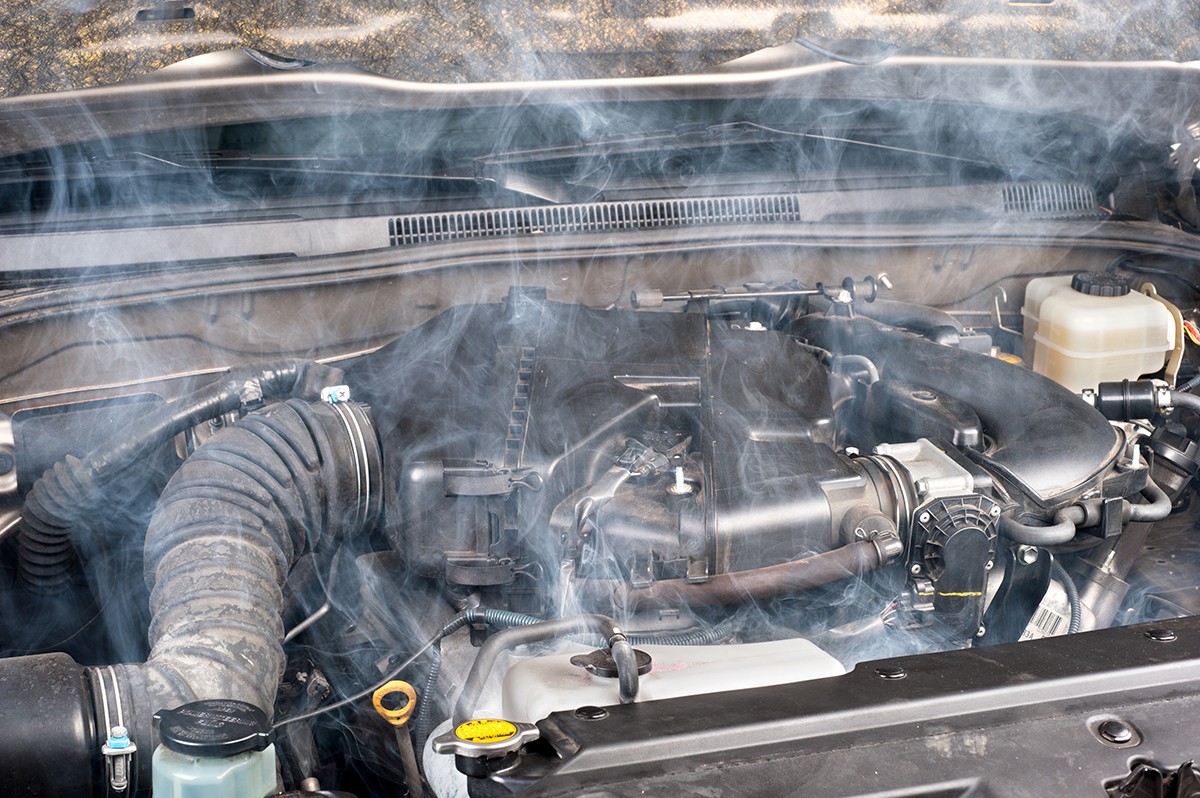Your car’s thermostat, though small, is vital for regulating engine temperature. A malfunctioning thermostat can cause various problems, from poor fuel economy to serious engine damage due to overheating. This article will explore the telltale signs of a bad thermostat and guide you through the repair process.
 A smokey car engine shows signs of a lack of maintenance.
A smokey car engine shows signs of a lack of maintenance.
Recognizing a Faulty Car Thermostat: Key Symptoms
-
Unstable Temperature Gauge Readings: One of the first indicators of a thermostat problem is erratic behavior in your car’s temperature gauge. If you observe the gauge fluctuating rapidly between normal and hot, or moving in an unpredictable manner, it’s a strong sign that the thermostat might be failing to regulate coolant flow properly. This inconsistency is a direct result of the thermostat’s inability to open and close as needed to maintain a stable engine temperature.
-
Engine Overheating: A consistently high temperature reading on your dashboard is a critical warning sign. Engine overheating typically occurs when the thermostat is stuck closed, preventing coolant from circulating through the radiator to dissipate heat. If you notice your temperature gauge consistently in the hot zone, pull over safely as soon as possible. Continuing to drive an overheating engine can lead to severe damage, including warped cylinder heads or a cracked engine block.
-
Reduced Fuel Efficiency: A malfunctioning thermostat can negatively impact your car’s fuel economy. When a thermostat is stuck open or not closing fully, the engine may take longer to reach its optimal operating temperature. In this ‘cold’ running state, the engine control unit (ECU) commands a richer fuel mixture to compensate, leading to increased fuel consumption. If you notice a sudden and unexplained drop in your miles per gallon, a faulty thermostat could be the culprit.
-
Ineffective Car Heater: Problems with your car’s heating system can also point to a thermostat issue. The thermostat plays a role in directing coolant flow to the heater core, which is responsible for warming the air inside your vehicle. If the thermostat is stuck open, it can restrict coolant flow to the heater core, resulting in weak or no heat in the cabin, especially during cold weather.
-
Coolant Level Drops: While not always directly caused by the thermostat itself, persistent low coolant levels can sometimes be linked to thermostat problems. A thermostat that is stuck closed can create excessive pressure within the cooling system. This pressure can, in turn, lead to leaks in hoses, the radiator, or other cooling system components, causing coolant loss. If you find yourself frequently adding coolant to your system, it’s important to investigate the entire cooling system, including the thermostat.
Repairing a Car Thermostat: A Step-by-Step Guide
-
Accurate Diagnosis is Key: Before you begin any repair work, it’s crucial to confirm that the thermostat is indeed the source of the problem. While the symptoms listed above are indicative, a proper diagnostic check is essential. A mechanic can use diagnostic tools, such as an OBD-II scanner, and perform cooling system tests to accurately pinpoint the issue. This step prevents unnecessary part replacements and ensures you address the actual problem.
-
Thermostat Replacement Procedure: If the diagnosis confirms a faulty thermostat, replacement is usually the recommended course of action. Here’s a general outline of the process:
- Locate the Thermostat Housing: The thermostat housing is typically situated where the upper radiator hose connects to the engine block. Consult your vehicle’s repair manual for the exact location.
- Coolant Drainage: Before opening the system, allow the engine to cool down completely. Then, carefully drain some coolant from the radiator or drain plug to reduce pressure and prevent spillage.
- Housing Removal: Disconnect any hoses or sensors attached to the thermostat housing. Unbolt the housing and carefully remove it. Be prepared for some coolant to spill.
- Thermostat Extraction and Replacement: Note the orientation of the old thermostat before removing it. Install the new thermostat in the same orientation. Ensure the rubber gasket or O-ring is in good condition or replace it with a new one to prevent leaks.
- Housing Reassembly: Clean the mating surfaces of the thermostat housing and engine block. Reinstall the housing, tightening bolts to the manufacturer’s specified torque. Reconnect hoses and sensors.
- Refill Coolant and Bleed the System: Refill the cooling system with the correct type and mixture of coolant. Bleed the system to remove any air pockets, which can cause overheating. This may involve running the engine with the radiator cap off (follow specific procedures for your vehicle).
-
Coolant System Flush (Recommended): When replacing the thermostat, it’s an opportune time to perform a complete coolant system flush. Over time, coolant can degrade and accumulate contaminants, which can hinder cooling efficiency and potentially damage new components. Flushing the system removes old coolant and debris, ensuring optimal performance of the new thermostat and the entire cooling system.
-
Preventative Maintenance: To minimize future thermostat problems and maintain a healthy cooling system:
- Regular Coolant Checks: Periodically check your coolant level and condition. Maintain the correct coolant level and replace coolant according to your vehicle’s maintenance schedule (typically every 2-5 years or 30,000-60,000 miles).
- System Inspections: Regularly inspect hoses, clamps, and the radiator for leaks or damage. Address any issues promptly.
- Professional Check-ups: Include cooling system inspections as part of your routine car maintenance, especially before extreme weather seasons.
A faulty car thermostat can lead to significant engine problems if ignored. By understanding the signs of a failing thermostat and knowing the repair steps, you can take proactive measures to maintain your vehicle’s health. While thermostat replacement can be a DIY task for experienced individuals, if you are unsure or uncomfortable working on your car’s cooling system, it’s always best to consult a qualified mechanic. Regular maintenance of your cooling system is a key factor in ensuring the longevity and reliability of your vehicle.
